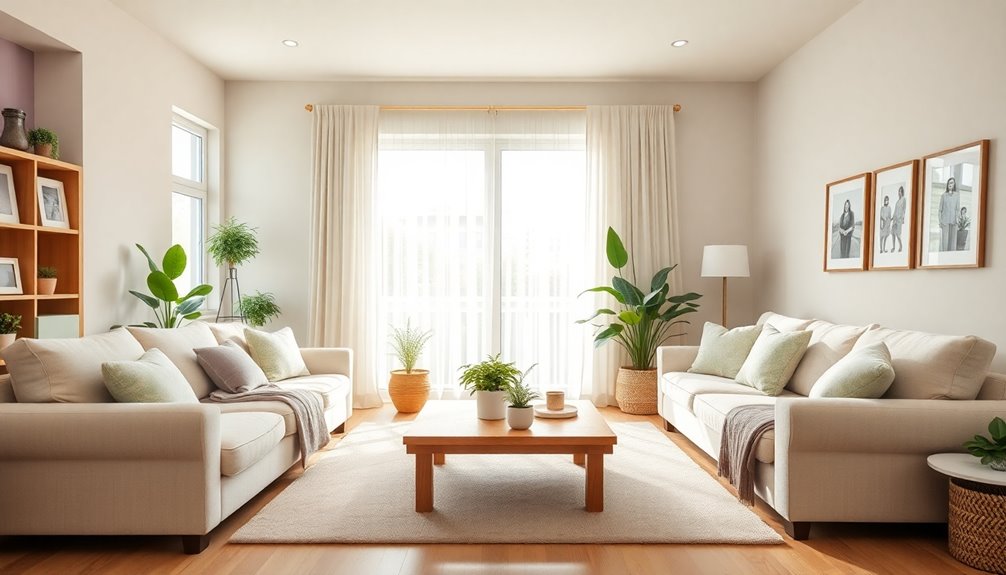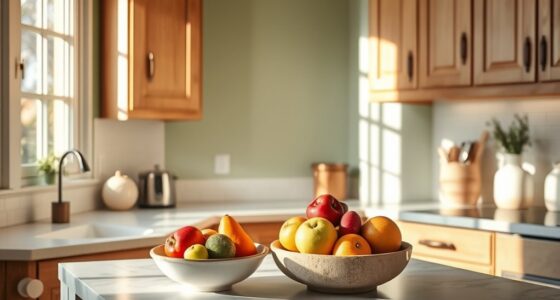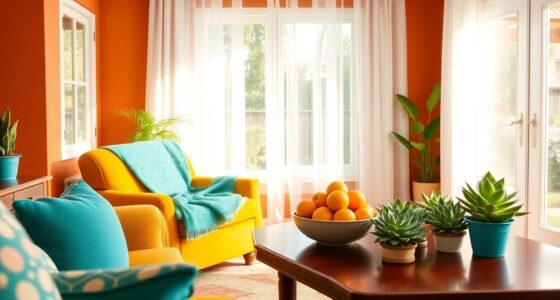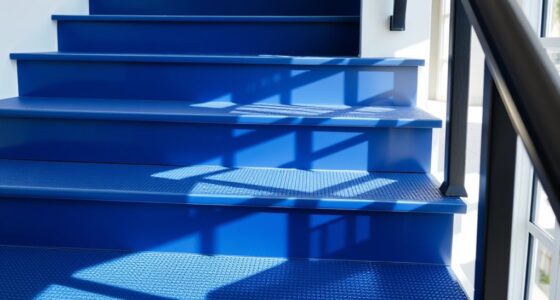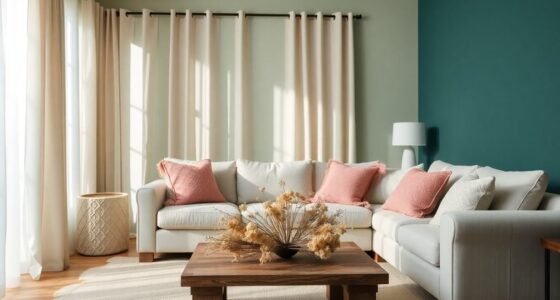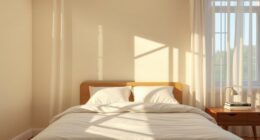To create an elderly-friendly home, consider using vibrant colors like red for energy or soft blue for calmness. Green offers comfort, while brown promotes safety and warmth. Add purple for creativity and bright accents for visibility. Soft yellows can uplift moods, and combining lilac, brown, and white creates a cozy atmosphere. Each color serves a purpose, enhancing safety and comfort. Stay tuned to discover even more inspiring color schemes for your space! Incorporating soothing color palettes for elderly homes can significantly contribute to a peaceful environment, making daily living easier and more pleasant. Consider utilizing pastel shades, which can enhance serenity while reducing visual stress. Furthermore, integrating textured materials in these colors will not only improve aesthetics but also offer tactile stimulation that can benefit cognitive engagement.
Key Takeaways
- Use soft yellows to create warm, inviting spaces that uplift spirits and promote a sense of security for seniors.
- Incorporate soft blues in living areas to evoke calmness and alleviate anxiety, enhancing overall well-being for elderly residents.
- Deep green tones and plants connect seniors to nature, creating a comforting atmosphere that promotes relaxation and tranquility.
- Brown accents provide a cozy, stable environment, enhancing visibility and fostering social interactions among family members.
- Bright accents against darker colors improve visibility and spatial awareness, supporting cognitive function and reducing accident risks for seniors.
Red for Energy
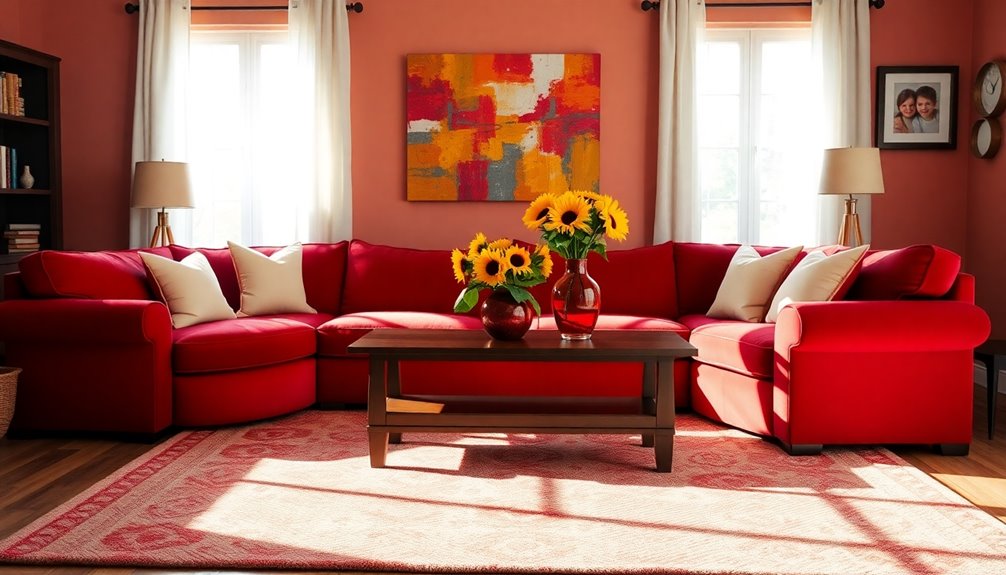
Energy is essential for a vibrant home, and incorporating red can help achieve that lively atmosphere.
Using red in your living space can stimulate energy and excitement, perfect for areas like breakfast nooks to combat winter sluggishness. Bright red tablecloths and window accents enhance vibrancy, positively influencing mood and creating a comfortable environment.
Full red walls can amplify energy, encouraging social interaction among family and friends. Additionally, red is known to stimulate appetite, making it a great choice for dining areas in elderly-friendly homes.
The psychological impact of red can increase heart rate and excitement, promoting a more active and lively lifestyle for seniors.
Embrace red to invigorate your home and uplift spirits!
Soft Blue for Calm
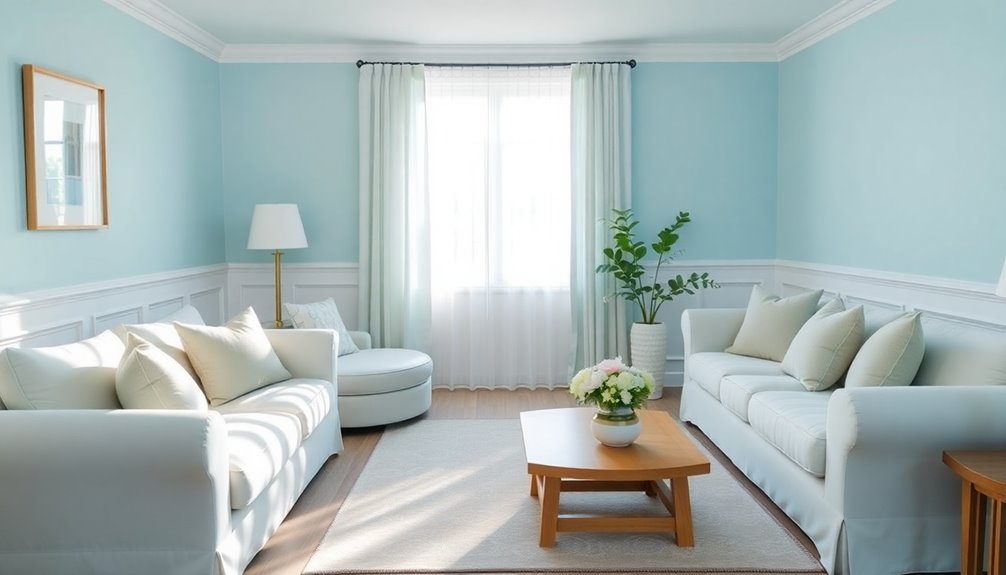
After bringing energy into your home with vibrant red, consider soft blue to create a calming retreat.
Soft blue tones evoke images of the ocean and sky, promoting a sense of calm that's perfect for spaces where seniors spend time. This soothing color is often found in spas and bathrooms, enhancing the overall well-being of your home environment.
You can make leisurely areas, like dining spaces, feel comfortable and safe by incorporating soft blue throw blankets and cushions.
While it's ideal for warmer seasons, you might want to adjust during winter to avoid a cold feel.
Embracing soft blue can help alleviate anxiety and stress, ensuring a peaceful living experience for elderly individuals in your home.
Green for Comfort

Green is a color that embodies the essence of nature, bringing a sense of comfort and tranquility into your home.
For an elderly-friendly space, deep or emerald green tones create a relaxing atmosphere, perfect for areas where seniors spend time, like entertainment rooms or reading nooks. You can enhance this cozy vibe with green velvet day beds or furniture, promoting relaxation and comfort.
Additionally, incorporating plants with lush green foliage not only beautifies the space but also improves air quality and connects seniors to nature, boosting their overall well-being. Using proper ventilation in these areas is essential to ensure a healthy environment for seniors.
Green's versatility makes it an ideal choice for any season, ensuring your home remains a comforting sanctuary for older residents year-round.
Brown for Safety
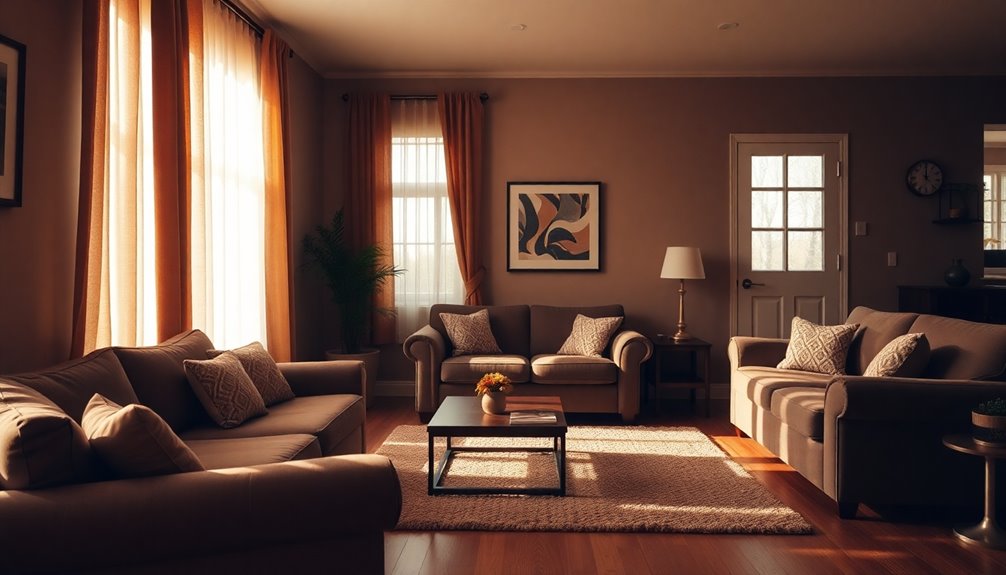
Brown hues, especially cocoa brown, evoke a cozy, cocoon-like feeling that's crucial for creating a safe and comforting environment in elderly-friendly homes. These colors are associated with stability and reliability, which helps alleviate anxiety and promotes relaxation for older adults.
To enhance this warmth, consider incorporating deep brown accents like pillows and rugs. Using dark brown furniture against lighter walls creates high contrast, aiding visibility and helping seniors distinguish between surfaces, thereby reducing fall risks.
Additionally, implementing brown tones in living areas encourages gatherings with family and friends, reinforcing social connections that are significant for elderly well-being.
Purple for Creativity
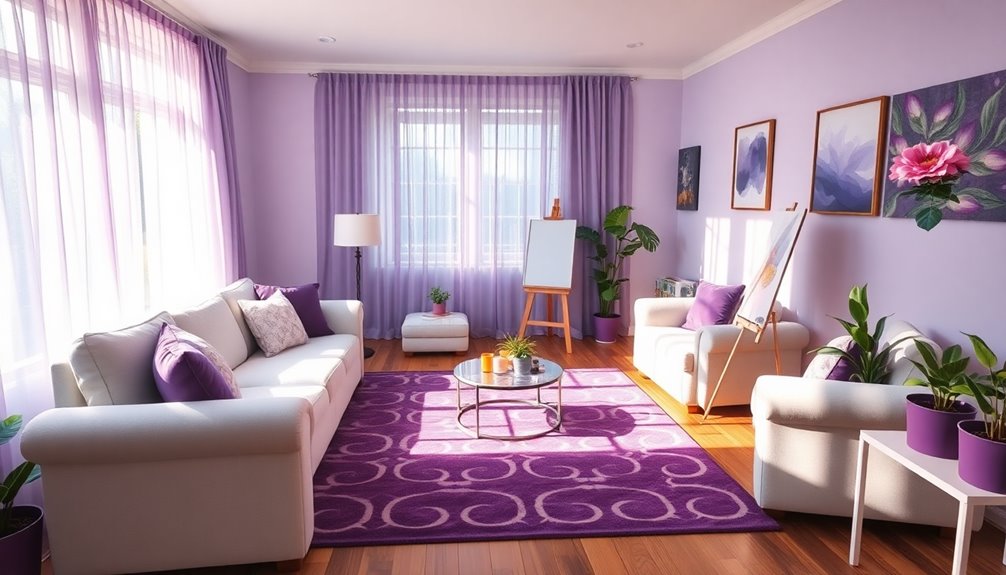
Using purple in your home can really boost creativity, making it a great choice for spaces like craft rooms or offices.
Lighter shades create a calming vibe, while deeper tones add warmth during the colder months.
Stimulating Creative Environments
When you choose purple for your creative spaces, you're tapping into a color that historically sparks imagination and innovation. Utilizing purple in your home design fosters a stimulating creative environment, perfect for offices or craft rooms.
Deeper hues bring warmth and richness during colder months, enhancing the overall creative atmosphere. While light purples can feel a bit chilly in winter, balancing these tones guarantees your space remains cozy and inviting.
To inspire artistic expression, consider incorporating purple accents like cushions or artwork. These elements not only maintain visual engagement but also encourage creativity and innovation.
Color Psychology Benefits
Incorporating purple into your home not only enhances creativity but also taps into the powerful psychology of color. This rich hue, particularly in deeper shades like eggplant or plum, provides warmth and sophistication, making it a perfect addition to your elderly-friendly color scheme.
These warm colors stimulate the brain's creative centers, encouraging artistic expression in spaces like craft rooms or offices. While lighter purples uplift during spring and summer, deeper tones create a cozy, inviting atmosphere in colder months. Additionally, herbal remedies can also promote overall well-being, enhancing the positive effects of a thoughtfully designed space. In creating these environments, consider the impact of cacao's health benefits, which can further support emotional clarity and mood enhancement.
Orange for Appetite
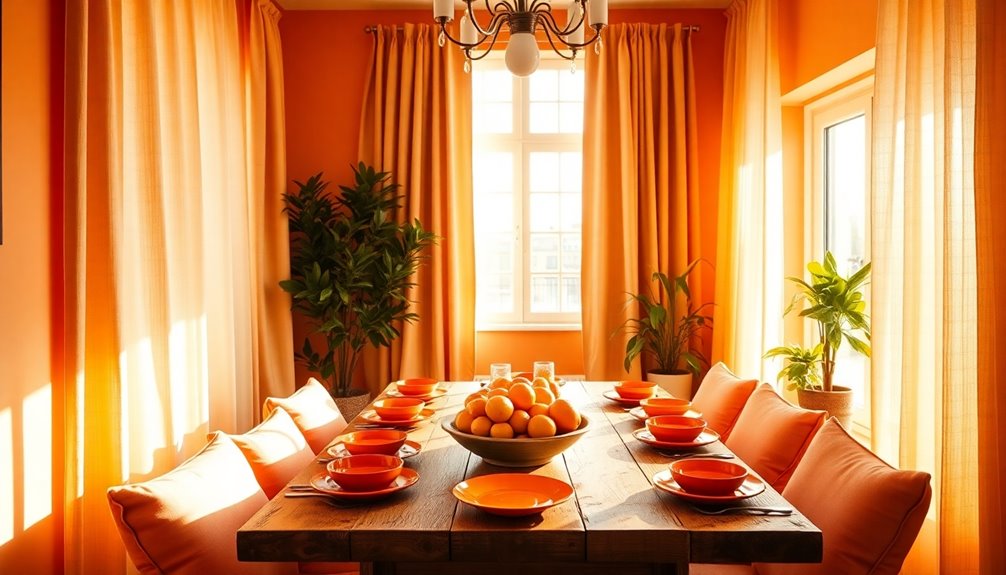
The vibrant hue of orange can transform your dining space into a warm and inviting atmosphere, perfect for stimulating appetite. This lively color not only enhances the dining experience but also promotes social interaction during meals. Soft shades of orange create a cozy environment that nurtures relaxation and comfort, essential for seniors' well-being. When combined with warm neutrals, orange reduces feelings of isolation and fosters community.
| Benefits of Orange in Dining | Description |
|---|---|
| Stimulates Appetite | Encourages seniors to enjoy meals |
| Evokes Positive Emotions | Combats feelings of sluggishness |
| Promotes Social Interaction | Creates a lively dining atmosphere |
| Enhances Comfort | Soft shades provide a cozy ambiance |
| Supports Well-Being | Contributes to overall emotional health |
White for Space
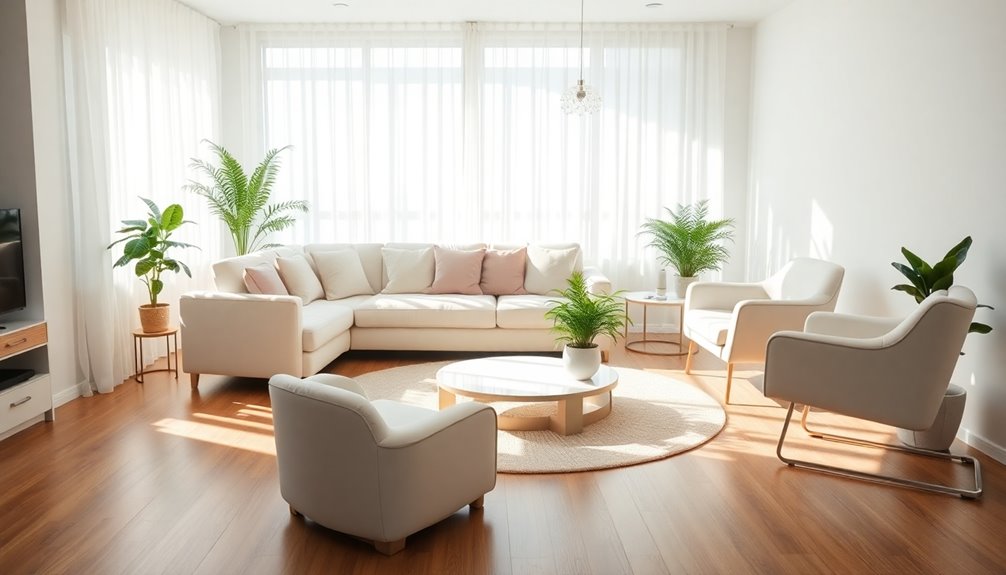
Creating a sense of space in your home is essential, especially for seniors who might feel confined. White walls can create an illusion of increased space, making your rooms feel more open and airy. This is particularly beneficial for elderly individuals.
The reflective nature of white enhances natural light, improving visibility and reducing the risks of accidents from poor lighting. A white color scheme promotes a clean and calming environment, helping to alleviate stress and foster relaxation. Additionally, ensuring optimal performance of air purifiers in these settings can significantly improve air quality, further supporting the well-being of elderly residents. Incorporating HEPA filters in air purifiers can effectively reduce allergens, enhancing respiratory health for seniors. Regular cleaning of air purifiers is also essential to maintain their effectiveness in providing clean air.
You can also pair high-contrast elements, such as dark furniture against white walls, to enhance navigation and visibility. Plus, white serves as a versatile base color, allowing you to add warmer tones for a personalized, comforting atmosphere without overwhelming the space.
Black for Relaxation
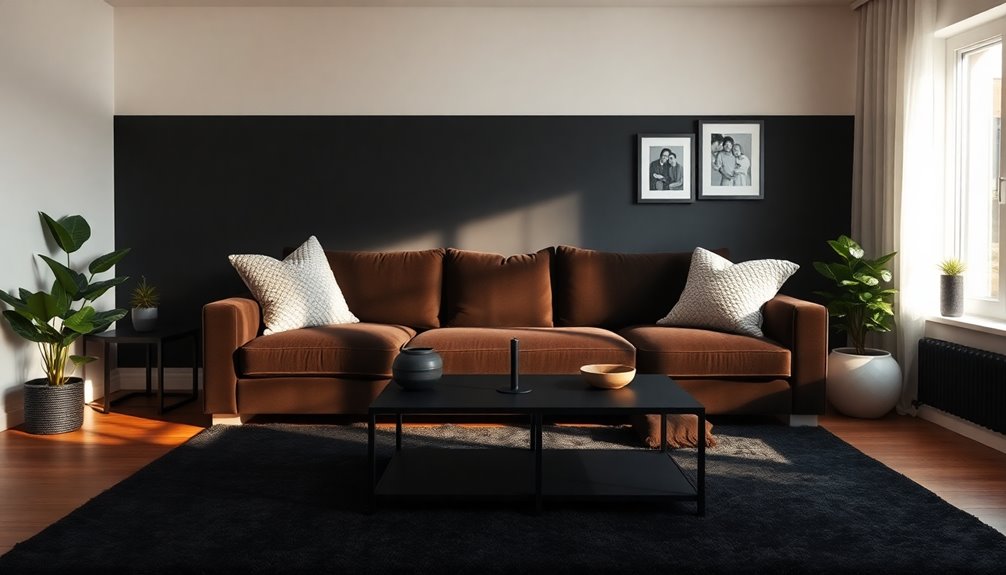
Using black in your home can create a calming atmosphere, especially when you pair it with brighter accents for contrast.
It's a versatile choice that enhances elegance while promoting relaxation.
Calming Atmosphere Benefits
While many might think of black as a bold choice, it can actually foster a calming atmosphere in an elderly-friendly home when paired with softer hues.
Incorporating black accents, like furniture or decor, enhances visual contrast, making it easier for seniors to navigate and identify different areas without confusion. Additionally, using a home security system can help ensure that seniors feel secure and comfortable in their environment. Creating spaces that promote aging in place is essential for a seamless living experience.
Using black in moderation brings a sense of grounding and stability, contributing to relaxation and security. To guarantee the space remains inviting, pay attention to lighting; well-lit areas with black elements feel less constrictive and more comfortable.
This thoughtful integration not only promotes tranquility but also prevents overwhelming darkness, creating a harmonious environment that supports the needs of elderly residents. Additionally, ensuring that the home is equipped with home security systems can enhance the sense of safety and peace of mind for elderly individuals.
Contrast With Bright Accents
Incorporating bright accents against a black backdrop not only enhances visual clarity but also fosters a lively atmosphere in an elderly-friendly home.
Using black as a base color creates a calming effect, while high-contrast color schemes improve visibility, helping seniors easily distinguish between surfaces and objects. The use of color schemes can be a crucial element in designing spaces that are not only functional but also aesthetically pleasing for seniors. Additionally, incorporating mindfulness practices can help create a serene environment that further supports emotional well-being.
Pairing black with vibrant colors like yellow or orange can stimulate positive moods and add warmth. This combination caters to the emotional needs of seniors, grounding their space while infusing energy.
Well-placed bright accents in a largely black room improve spatial awareness, making navigation simpler and reducing accident risks. Additionally, creating an environment with cognitive function can further support the mental clarity and well-being of seniors.
Versatile in Design Use
How can black contribute to a peaceful atmosphere in your home? When used wisely, black adds depth and sophistication, creating a calming effect.
Pairing black with lighter colors enhances contrast and promotes relaxation. Incorporating black accents, like furniture or decor, grounds the space, making it feel secure for elderly individuals. Moreover, smart fixtures can be integrated into a black-themed bathroom design, enhancing both functionality and aesthetics. Additionally, air purifiers can help improve indoor air quality, contributing to a healthier living environment for seniors.
You can effectively use black in cozy areas like reading nooks or bedrooms, fostering tranquility. Textured black materials, such as velvet, add a tactile dimension, inviting seniors to engage with their environment.
Additionally, warm lighting softens the overall feel, enhancing the serene ambiance. With its versatility, black not only elevates your design but also provides ease of use in creating a comforting, elderly-friendly home. Furthermore, incorporating moisture-resistant materials can ensure longevity and safety in spaces like bathrooms, which is essential for elderly-friendly designs.
Soft Yellows for Happiness
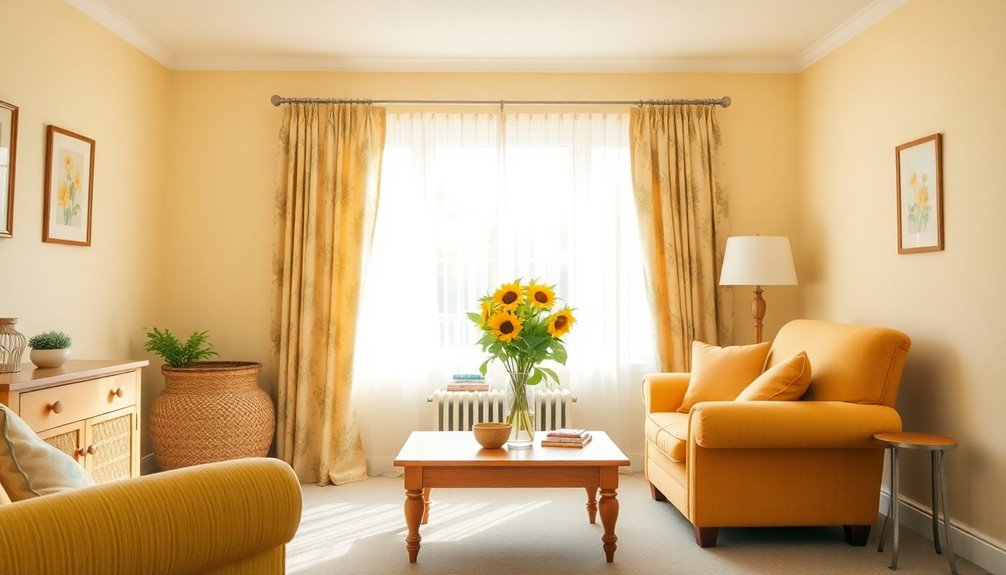
Soft yellows can transform a living space into a haven of happiness and positivity, making them a perfect choice for elderly-friendly homes. This cheerful hue reflects more light, enhancing visibility and creating warm, inviting spaces that are especially beneficial for seniors with diminished vision.
By incorporating soft yellow accents—like paint, curtains, or decorative pillows—you can help counter feelings of inactivity and depression that often affect older adults. Yellow's association with warmth and energy promotes a sense of security and comfort, essential for a positive living environment.
When paired with neutral colors such as white or light beige, soft yellows foster a balanced and harmonious setting, ensuring your home feels both cozy and vibrant while uplifting spirits.
Lilac, Brown, and White
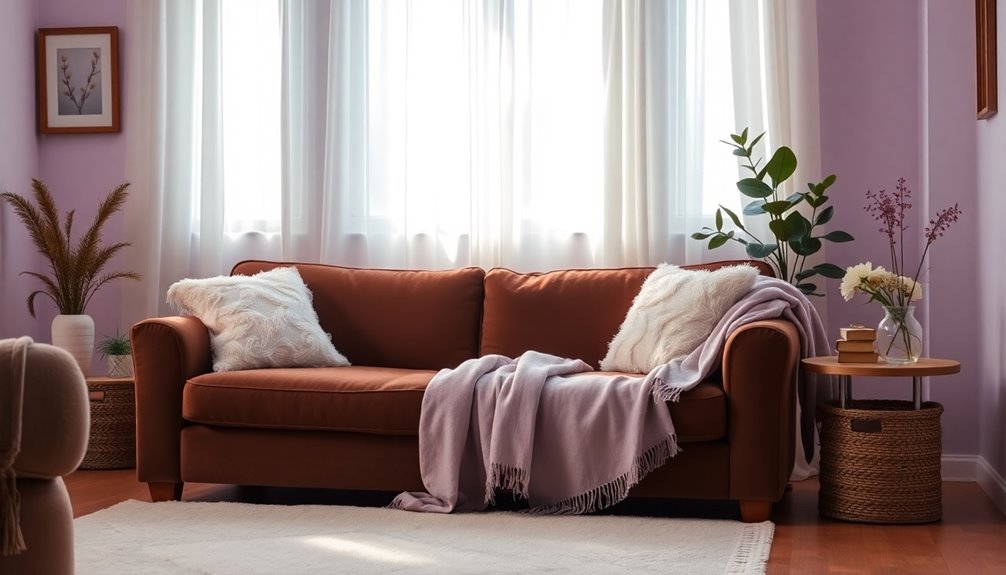
Brightening a home with soft yellows is just one way to create a welcoming atmosphere for seniors. However, consider using lilac, brown, and white for a cozy and inviting space. The calming effect of lilac promotes relaxation, ideal for bedrooms and leisure areas. When paired with dark brown furnishings, it adds richness and depth, enhancing the overall warmth. White accents create a bright, airy feel, improving lighting and mood for older adults.
| Color | Effect |
|---|---|
| Lilac | Calming, promotes relaxation |
| Brown | Adds depth, warmth |
| White | Brightens space, enhances lighting |
Incorporating lilac decor allows personalization, fostering a comforting environment that feels familiar.
Frequently Asked Questions
What Are the Elderly Friendly Colors?
When considering elderly-friendly colors, think about warm hues like yellows and oranges for communal areas to boost energy and happiness.
For restful spaces, soft blues and greens can create a calming atmosphere.
You'll also want high-contrast schemes, like dark browns paired with white, to help distinguish surfaces and reduce accidents.
Finally, deep colors like emerald green can enhance comfort, while pastels add a soothing touch without overwhelming the senses.
What Color Is Easiest for Elderly?
When considering what color is easiest for the elderly, high-contrast shades like dark brown and white stand out. They help improve visibility and make it easier to distinguish between surfaces.
Warm colors, such as soft yellows and oranges, can also enhance mood and create a cozy atmosphere.
Meanwhile, deep greens and light purples offer a soothing vibe, ensuring comfort and relaxation in living spaces.
Choose colors that promote safety and well-being for older adults.
How Can I Make My House Elderly Friendly?
Imagine your home as a warm embrace, welcoming every visitor with open arms. To make your house elderly-friendly, focus on eliminating hazards and enhancing comfort.
Start by decluttering walkways and using non-slip rugs. Install grab bars in bathrooms and guarantee furniture is sturdy yet accessible.
Use soft lighting to brighten spaces without glare, and choose colors that evoke calmness.
Small changes can create a haven where everyone feels safe and at ease.
What Colors Do Elderly See Best?
Elderly individuals often see warm colors, like yellow and orange, best, as they're easier to perceive and can brighten up a space.
High-contrast combinations, such as dark accents against lighter backgrounds, enhance visibility and help prevent accidents.
Soft blues and greens create a calming atmosphere, while avoiding overly vibrant blues and violets can be beneficial since those colors may become harder to distinguish.
Prioritizing these hues can improve comfort and navigation for seniors.
Conclusion
By choosing the right color schemes, you can transform any space into an elderly-friendly haven that feels like paradise. Whether it's the calming soft blue or the energizing red, each color brings something special to the table. So go ahead, paint those walls and watch your home blossom into a vibrant sanctuary! With just a few brush strokes, you'll create an environment that nurtures comfort, safety, and happiness—making every day feel like a warm hug.
